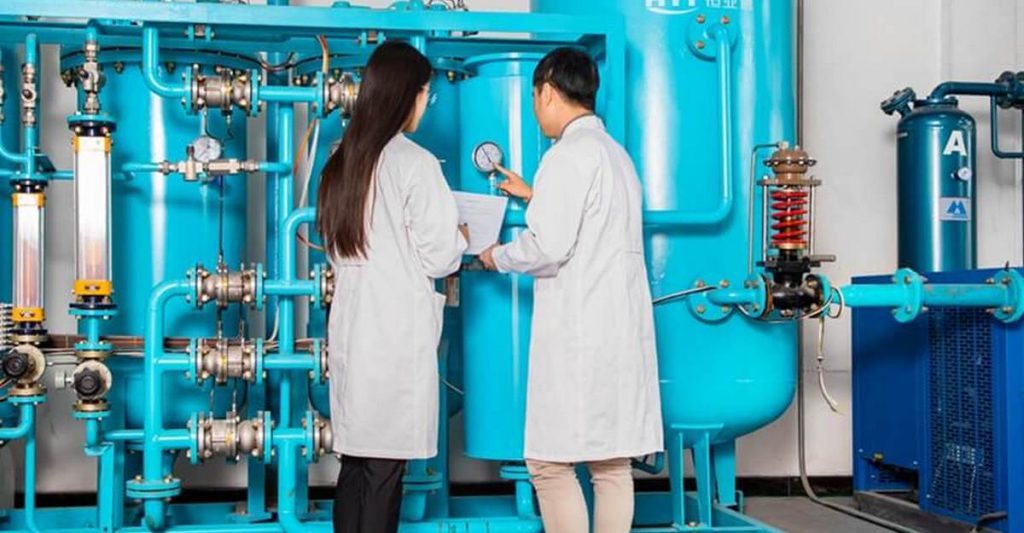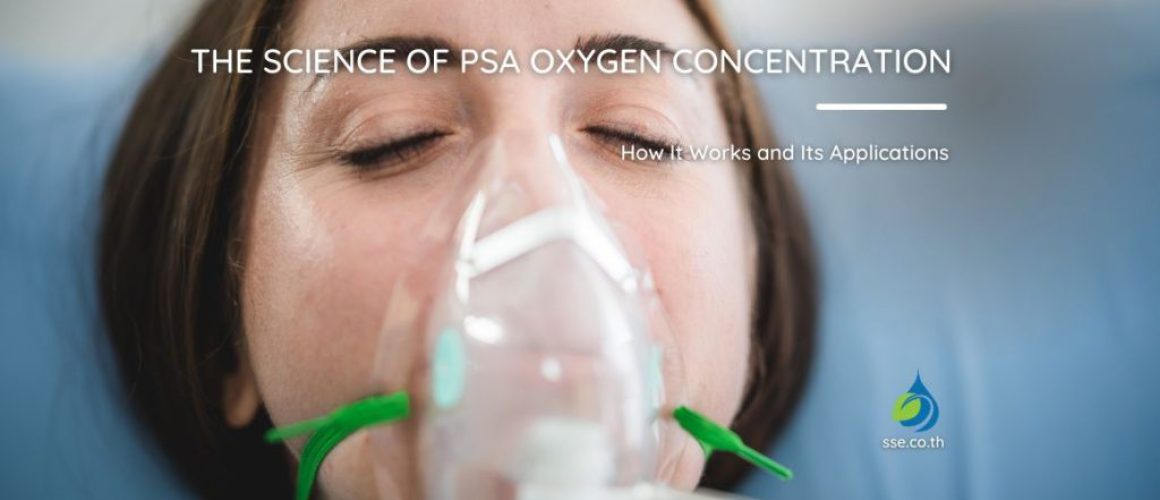The Science of PSA Oxygen Concentration: How It Works and Its Applications


Table of content
Have you ever wondered how hospitals and other facilities obtain a continuous supply of oxygen for various applications? The answer lies in a technology called Pressure Swing Adsorption (PSA). PSA oxygen concentration is a fascinating process that provides a reliable source of oxygen for a wide range of industries. In this article, we’ll dive into the science behind PSA oxygen concentration, explore how it works, and discuss its various applications. So, let’s get started!
Understanding Pressure Swing Adsorption
To fully comprehend the science of PSA oxygen concentration, we first need to understand the principle of Pressure Swing Adsorption itself. PSA is a technology used to separate specific gases from a mixture of gases under pressure. The process relies on the selective adsorption properties of certain materials, called adsorbents, which preferentially adsorb the target gas molecules.
How does a PSA oxygen generator work?
A PSA oxygen generator works by utilizing the adsorption properties of a material called zeolite. Zeolite is a microporous, crystalline solid with a high affinity for nitrogen molecules. When a gas mixture, such as air, is passed through a column packed with zeolite under pressure, the nitrogen molecules are preferentially adsorbed, while oxygen molecules pass through the column and are collected as product gas.
The PSA process consists of two main steps: adsorption and desorption. During the adsorption phase, pressurized air is fed into the column, and nitrogen molecules are adsorbed onto the zeolite. Once the zeolite becomes saturated with nitrogen, the pressure in the column is reduced, allowing the nitrogen to desorb from the zeolite and be vented to the atmosphere. This process is called desorption, and it regenerates the zeolite for the next cycle.
PSA oxygen generators typically use two adsorption columns operating in parallel to ensure a continuous supply of oxygen. While one column is in the adsorption phase, the other is in the desorption phase. This alternating process is known as “pressure swing” adsorption.
What is the purity of oxygen in PSA?
The purity of oxygen produced by a PSA system depends on several factors, including the type and quality of zeolite used, the operating pressure, and the design of the PSA unit. In general, PSA oxygen generators can achieve oxygen purities ranging from 90% to 95%. However, some specialized systems can produce oxygen with purities as high as 99%.


Beyond PSA: Key Molecular Sieve Processes
While PSA oxygen concentration is a major application, molecular sieves support a range of essential industrial processes. From gas separation and drying to catalytic support, these processes ensure high-purity outputs, moisture control, and effective contaminant removal across industries.
To discover how molecular sieves enhance these processes, check our full guide on Key Molecular Sieve Processes.
Specifications of PSA Oxygen Plants
PSA oxygen plants come in various sizes and capacities to cater to the needs of different industries. The specifications of a PSA oxygen plant typically include:
- Oxygen flow rate: The amount of oxygen produced per unit of time, usually measured in liters per minute (LPM) or cubic meters per hour (m³/h).
- Oxygen purity: The percentage of oxygen in the product gas, typically ranging from 90% to 99%.
- Operating pressure: The pressure at which the adsorption and desorption processes occur, usually between 4 and 7 bar.
Does PSA produce liquid oxygen?
No, PSA technology generates gaseous oxygen only. Liquid oxygen production requires a cryogenic process that cools and liquefies the air. Cryogenic oxygen production is a separate technology that operates at much lower temperatures and higher pressures than PSA.
Applications of PSA Oxygen Concentration
PSA oxygen concentration has found widespread use in various industries and applications, including:
- Medical: Hospitals and healthcare facilities rely on a continuous supply of oxygen for patient care, surgeries, and various medical treatments. PSA oxygen generators provide a reliable and cost-effective source of medical-grade oxygen for these facilities.
- Industrial: Many industrial processes applications, such as welding, cutting, and brazing, require a consistent supply of oxygen. PSA oxygen generators can help meet the demands of these industries by providing a continuous flow of high-purity oxygen.
- Aquaculture: Oxygen is essential for the health and growth of fish and other aquatic organisms. PSA oxygen concentration systems help maintain optimal oxygen levels in fish farming operations, ensuring the well-being of the aquatic species.
- Water treatment: PSA oxygen generators can be used in ozone generation systems for water purification and wastewater treatment. Ozone, a powerful oxidant, is produced by exposing oxygen to an electrical discharge.
- Glass and ceramics: The manufacture of glass and ceramic products often requires high temperatures, which can be achieved using oxygen-enriched combustion. PSA oxygen generators can provide the necessary oxygen to increase efficiency and reduce emissions in these industries.
- Mining and metallurgy: Oxygen is used in various mining and metallurgical processes, such as gold extraction, steelmaking, and non-ferrous metal production. PSA oxygen concentration systems can help enhance productivity and reduce environmental impacts in these sectors.
Molecular Sieves: Key to Purity in PSA Oxygen Concentration
Molecular sieves play a pivotal role in PSA oxygen systems, selectively adsorbing nitrogen to deliver high-purity oxygen essential for medical-grade applications. The choice of molecular sieve directly impacts oxygen purity and generator efficiency, especially in medical settings where reliability is paramount. For an in-depth exploration of molecular sieves specifically optimized for medical oxygen production, see our post on Molecular Sieves for Medical Oxygen Production.
What is a PSA unit?
A PSA unit, also known as a PSA oxygen generator or PSA system, is a piece of equipment that uses the Pressure Swing Adsorption process to concentrate oxygen from ambient air. A typical PSA unit consists of two adsorption columns filled with zeolite, a compressor, valves, and control systems to regulate the adsorption and desorption cycles.
What is PSA for vessels?
PSA for vessels refers to the application of PSA oxygen concentration technology in marine environments, such as onboard ships or offshore platforms. These systems provide a reliable source of oxygen for various applications, including medical emergencies, diving support, and water treatment.
What is oxygen PSA pressure?
Oxygen PSA pressure is the operating pressure at which the adsorption and desorption processes occur within the PSA system. The operating pressure is a critical factor affecting the efficiency and purity of the oxygen produced. Typically, PSA systems operate at pressures between 4 and 7 bar.
What does PSA mean in gas?
In the context of gas separation, PSA stands for Pressure Swing Adsorption, a process used to separate specific gases from a mixture under pressure. PSA is commonly used to concentrate oxygen, nitrogen, and hydrogen from air or other gas mixtures.
Frequently Asked Questions
How does oxygen PSA work?
A PSA oxygen generator works by utilizing the adsorption properties of a material called zeolite. When a gas mixture, such as air, is passed through a column packed with zeolite under pressure, the nitrogen molecules are preferentially adsorbed, while oxygen molecules pass through the column and are collected as product gas.
What is the working principle of PSA?
The PSA process consists of two main steps: adsorption and desorption. During the adsorption phase, pressurized air is fed into the column, and nitrogen molecules are adsorbed onto the zeolite. Once the zeolite becomes saturated with nitrogen, the pressure in the column is reduced, allowing the nitrogen to desorb from the zeolite and be vented to the atmosphere. This process is called desorption, and it regenerates the zeolite for the next cycle.
What is PSA plants for oxygen?
PSA plants for oxygen are facilities that use Pressure Swing Adsorption technology to produce a continuous supply of oxygen. They are commonly used in various industries such as medical, industrial, aquaculture, water treatment, glass and ceramics, and mining and metallurgy.
What is the capacity of the PSA oxygen plant?
The capacity of a PSA oxygen plant is usually measured in terms of the oxygen flow rate, which is the amount of oxygen produced per unit of time. This can be measured in liters per minute (LPM) or cubic meters per hour (m³/h).
What are the major components of PSA oxygen plant?
What are the major components of PSA oxygen plant?
What is the difference between PSA and cryogenic oxygen?
PSA technology generates gaseous oxygen only, while cryogenic oxygen production involves a process that cools and liquefies the air. Cryogenic oxygen production operates at much lower temperatures and higher pressures than PSA.
What is the difference between membrane and PSA technology?
Both membrane and PSA technologies are used for gas separation, but they work on different principles. PSA uses adsorbents to selectively adsorb certain gases, while membrane technology uses a semi-permeable membrane to separate gases based on their molecular size and solubility.
What are the advantages of PSA oxygen plant?
PSA oxygen plants provide a reliable and cost-effective source of high-purity oxygen. They can cater to the needs of various industries and applications, and can be designed to produce different flow rates and oxygen purities.
What is the flow generated by PSA plant?
The flow generated by a PSA plant, also known as the oxygen flow rate, is the amount of oxygen produced per unit of time. This can be measured in liters per minute (LPM) or cubic meters per hour (m³/h).
How does PSA remove nitrogen from natural gas?
Pressure Swing Adsorption (PSA) removes nitrogen from natural gas by utilizing the adsorption properties of a material called zeolite. When a gas mixture, such as natural gas, is passed through a column packed with zeolite under pressure, the nitrogen molecules are preferentially adsorbed, while other gas molecules pass through the column. Once the zeolite becomes saturated with nitrogen, the pressure in the column is reduced, allowing the nitrogen to desorb from the zeolite and be vented to the atmosphere. This process is called desorption, and it regenerates the zeolite for the next cycle. This cycle of adsorption and desorption effectively separates nitrogen from the natural gas, resulting in a purer product gas.
Wrapping Up
The science of PSA oxygen concentration is an impressive technology that enables a continuous supply of high-purity oxygen for diverse applications across industries. By utilizing the selective adsorption properties of zeolite in the pressure swing process, PSA systems efficiently concentrate oxygen from ambient air, making them essential in medical, industrial, and environmental applications. For a broader understanding of gas separation principles, visit our page on Gas Separation with Molecular Sieves, and explore A Comprehensive Guide to Molecular Sieves for more foundational knowledge. For further reading on the underlying science, see the Wikipedia entry on Pressure Swing Adsorption.
ขอบคุณที่ใช้เวลาอ่านบทความของเราเกี่ยวกับการป้องกันความชื้น ทางเราหวังว่าท่านจะได้รับข้อมูลที่มีคุณค่าและเป็นประโยชน์ ทางเรายินดีให้บริการการปรึกษาฟรีเพื่อพูดคุยเกี่ยวกับความต้องการของท่านและให้คำแนะนำเกี่ยวกับวิธีการป้องกันความชื้นที่กำหนดเฉพาะสำหรับคุณ โปรดติดต่อเราที่ 0858124188 เพื่อนัดหมายการปรึกษาหรือเยี่ยมชมร้านค้าของเราเพื่อค้นหาผลิตภัณฑ์ที่ช่วยป้องกันสินค้าของคุณจากความเสียหายจากความชื้น ทางเราหวังว่าจะได้รับข่าวสารจากท่านเร็วๆนี้
